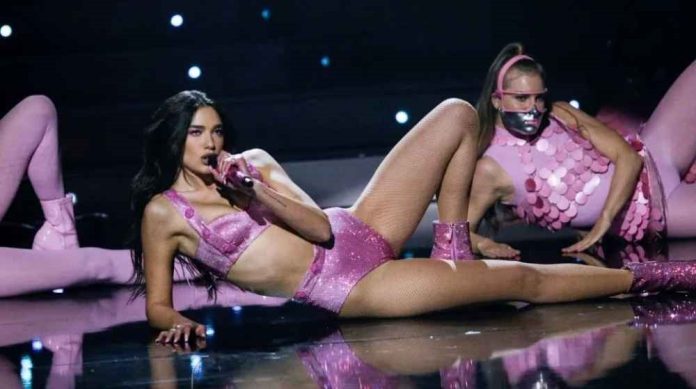
Dua Lipa has solidified her position as one of the top pop artists of recent years, with chart-topping hits that seamlessly blend modern production and nostalgic rhythms from past decades. By drawing inspiration from the sounds of the ’70s, ’80s, and ’90s, she taps into listeners’ emotions, creating a sense of familiarity that resonates with a broad audience. This article delves into how Dua Lipa’s use of nostalgia-driven rhythms contributes to her widespread appeal and helps her dominate the pop music landscape.
The Power of Nostalgic Rhythms in Modern Pop
Nostalgia is a powerful emotional trigger, especially in music. For listeners, hearing sounds that evoke memories of past decades fosters a sense of comfort, escapism, and connection. In today’s pop music, nostalgic rhythms are being widely used to bridge the gap between past and present, and Dua Lipa is a master at this technique.
Her 2020 album Future Nostalgia is a perfect example of how she combines retro dance elements with cutting-edge production. The album takes cues from ’70s funk, ’80s electro-pop, and ’90s dance tracks, creating a sound that is both familiar and fresh. From the disco beats of “Don’t Start Now” to the synth-heavy lines of “Levitating,” Lipa’s ability to evoke the past while staying relevant to contemporary listeners is key to her chart-topping success.
Rhythmic Choices and Emotional Resonance
One of Dua Lipa’s strengths lies in her use of rhythms that mirror the danceable grooves of past decades, particularly from the ’70s and ’80s disco era. Songs like “Don’t Start Now” and “Levitating” feature the syncopated basslines and four-on-the-floor beats that are reminiscent of classic dance music, creating an irresistible pull for listeners.
- “Don’t Start Now” features an upbeat rhythm similar to iconic disco tracks. The syncopated bassline and infectious groove tap into the feel-good energy of the ’70s, making the song a modern anthem for the dance floor.
- “Levitating” brings in glittering synths and a rhythmic bounce reminiscent of ’80s electro-pop. By incorporating retro elements into these tracks, Lipa manages to create songs that feel familiar while maintaining a fresh, innovative sound.
These rhythmic choices not only make her songs danceable but also evoke a sense of nostalgia, connecting listeners to the eras that influenced her music.
The Cultural Appeal of Nostalgia in Music
Nostalgia is not just a personal experience; it’s a cultural phenomenon. In times of uncertainty—whether due to political unrest, a global pandemic, or personal challenges—listeners often seek comfort in familiar sounds. Dua Lipa’s nostalgic rhythms offer a musical escape to a more carefree past, when disco dominated dance floors and pop music had a distinct synth-driven edge.
As music industry expert [Name] explains, “Nostalgia in music allows listeners to tap into a time that feels simpler and more joyful. Dua Lipa’s retro-inspired sounds offer an emotional refuge, making her songs resonate with both older generations who lived through those eras and younger listeners discovering them for the first time.”
Her music reflects the broader cultural longing for connection and unity, especially in challenging times. Songs like “Don’t Start Now” and “Levitating” speak to this collective desire for escapism, blending the joy and vibrancy of the disco era with the polished production of today’s pop scene.
Nostalgia as a Key to Chart Success
Dua Lipa’s success can be largely attributed to her skillful use of nostalgic rhythms, which have resonated with a wide demographic of listeners. Fans of all ages are drawn to the familiar sounds of her music, making it more likely to be streamed, shared, and playlisted on platforms like Spotify and Apple Music.
In addition to her artistic choices, streaming algorithms favor songs with familiar chord progressions and beats. This familiarity increases engagement rates, making songs more likely to be promoted by algorithms and played repeatedly by listeners. Dua Lipa’s retro-driven production taps into these algorithms, further cementing her tracks on the charts.
Her ability to align with the broader trend of retro revival in pop music, seen in artists like The Weeknd and Bruno Mars, keeps her music relevant in an ever-evolving industry. By capitalizing on the resurgence of disco and ’80s pop, Lipa has managed to carve out a distinct space for herself, standing at the forefront of modern pop with her unique blend of nostalgia and innovation.
Expert Insights on Dua Lipa’s Nostalgia-Driven Rhythm’s Appeal
According to [Music Industry Analyst Name], “Dua Lipa has managed to master the art of combining nostalgia with modern production techniques. Her music evokes memories of past decades while feeling completely fresh and relevant to today’s audience.”
Fans agree, with many pointing out that Lipa’s music connects them to multiple generations of pop. As one listener puts it, “It feels like a mix of what my parents listened to and the pop music I love today. There’s something about it that’s both comforting and exciting.”
The Future of Nostalgic Rhythms in Pop Music
As nostalgia continues to play a central role in contemporary pop music, Dua Lipa’s approach will likely serve as a blueprint for future artists. The key to her success lies in striking the perfect balance between familiar rhythms and innovative production, ensuring that her music appeals to a broad audience while remaining fresh and forward-thinking.
Lipa’s ability to evoke the past while maintaining a modern edge ensures her continued relevance in the pop world. As she looks to the future, nostalgic rhythms will likely remain a key element of her sound, keeping her at the top of the charts and inspiring a new wave of artists.
Conclusion: Nostalgia as the Key to Dua Lipa’s Success
Music Industry Weekly acknowledges that Dua Lipa’s use of nostalgic rhythms has been instrumental in her rise to the top of the charts, offering listeners a blend of familiar sounds and modern production that evokes deep emotional responses. By drawing from the musical traditions of the ’70s, ’80s, and ’90s, she taps into a rich cultural memory, providing her audience with both comfort and excitement. As pop music continues to evolve, her mastery of nostalgia-driven rhythms will likely remain a defining element of her enduring appeal, shaping the future of pop music.







